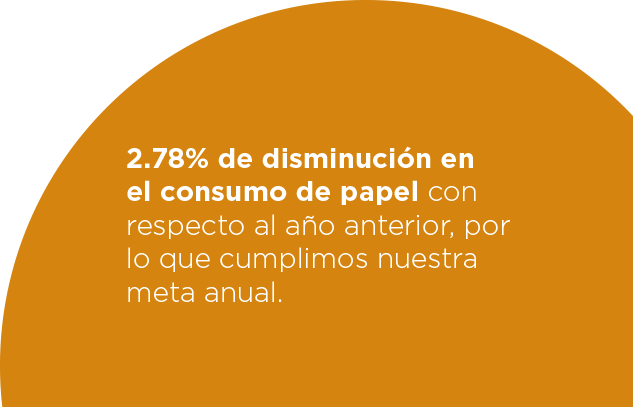“What we did with this reforestation drive is contribute to a greener country and to the creation of more ‘lungs’ for the planet. Individual participation is crucial for a balanced coexistence with the environment”.


At Crédito Real we believe that social well-being and a prosperous economy depend to a large extent on responsible management of natural resources and mitigation of climate change. For this reason, in 2018 our commitment to environmental protection and sustainability was asserted by incorporating it into our Code of Ethics and Conduct.
The actions with which we contributed to this subject in 2018 were two: the optimization in the use of resources and the volunteer program “Reforestemos juntos”, which we implemented at the forest area of Tepotzotlán in the State of Mexico. The latter was a reforestation drive through which we raised the awareness of participants of the value of trees and the importance of the preservation of green areas and forests.
In 2019 we will implement an action plan for understanding the impact of these initiatives on our community and promoting actions of mitigation and adaptability to climate change of our activities.
Through or volunteer program “Reforestemos juntos” we managed to reforest half a hectare in the community of San Francisco Magú, Tepotzotlán, in the State of Mexico, planting more than 1,900 trees, that achieved a survival rate of 80.00% by the end of the year.
We evaluated our energy and emission results with the methodology established by the Registro Nacional de Emisiones (RENE) para Gases y Compuestos de Efecto Invernadero (National Registry of Greenhouse Gas Emissions). Operational limits of the inventory are defined by the standard NMX-SSA-14064-1-IMNC-20071; that is, the identification of operation-related emissions of the company and their classification into direct and indirect emissions.
Our 2019 commitments are to continue with the identification of environmental risks and opportunity areas and develop a climate strategy.

Our headquarters building is LEED Gold-certified; its infrastructure is designed to increase our energy efficiency by means of physical adaptations and monitoring, as well as through energy-saving initiatives such as doubleglazing windows and use of natural light in addition to the time of our work activities.
The energy consumption of our operations derives from two sources: electricity for interior use, and fossil fuel (gasoline) for exterior use.



We managed to reduce our electricity consumption by 18.81%.

We firmly believe that simple actions, like the upgrading of our videoconference and remote meeting capacities to improve communications has had a deep impact on our progress towards environmental sustainability.
0.41 metric tons of CO2e emitted per collaborator in 2018; a reduction of 58.59% with respect to the previous year.
In order to make further reductions of our emissions, we plan to have our collaborators answer questionnaires that will help us find out the viability of implementing sustainable corporate mobility (carpooling), as well as other types of flexible work options (home office).


Notes:
Since 2015, Crédito Real’s headquarters has been the Torre Vistral building, the first one with LEED Gold certification in the Insurgentes corridor. The building’s water is supplied through two hydraulic systems:
Correct operation and balance of the WWTP depends on the amount, quality and cleanness of the wastewater it receives, as well as on the quantity and effectiveness of the beneficial bacteria in the sludge it handles, as it feeds on the organic matter in the sewage received.
Water use is included in the operation expenses of the building; water consumption in 2018 was 4,989.8 m3, a reduction of 2.10% with respect to 2017.

Water is discharged into the Drainage System of the Water System of Mexico City.
Savings in water consumption are partly due to the awareness the company has raised among collaborators through posts in the internal social networks, as well as through the “Cuidado del agua” (Water care) online training course for new collaborators. The purpose of these initiatives is to explain to our collaborators the source of the water we use and the difficulties in its supply; we also make recommendations for water care.
The most significant activity in the operation of our business is printing, therefore paper is our most relevant input. Hence, 50.00% of the paper we use has been recycled.
We are part of the program HP Planet Partners whose goal is to process recycle toner and ink cartridges in order to turn them into raw materials which may be used to manufacture new plastic and metal items.


